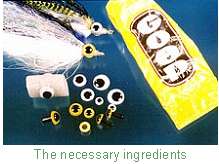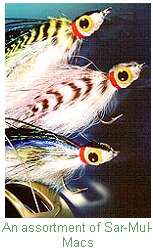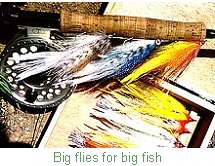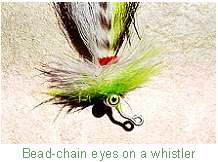 If there is one thing I’ve learned in nearly four decades of marine angling, it’s that eyes on flies and lures make them profoundly more productive. I wouldn’t consider tossing a “blind” salt water fly to any critter near shore or off shore; ditto for conventional artificials. I even go so far as to glue plastic optics on my lead head bucktail jigs. In fact, with the exception of bead eyes and lead dumbbells, I glue the eyes on all my marine baitfish monikers.
If there is one thing I’ve learned in nearly four decades of marine angling, it’s that eyes on flies and lures make them profoundly more productive. I wouldn’t consider tossing a “blind” salt water fly to any critter near shore or off shore; ditto for conventional artificials. I even go so far as to glue plastic optics on my lead head bucktail jigs. In fact, with the exception of bead eyes and lead dumbbells, I glue the eyes on all my marine baitfish monikers.
There are a variety of optics you may choose from to place on a fly or lure to enhance realism or further animate the fraud. Some need to be tied on the hook shank, such as bead chain or lead dumbbells and others need to be glued on. I tend to favour optics that embellish realistic impression while simultaneously enhancing action – “action optics” – eyes with weight and dimension, like the solid plastic doll eyes that range in size from 6 mm to 9 mm and come attached to a solid plastic post. Hollow, buoyant eyes with movable pupils are also popular for enhancing flies and lures, particularly those that will be fished on top, where additional weight could be a disadvantage. Another popular eye style are the 3-D, prismatic, sticky-back eyes marketed by Spirit River. 
Regardless of the type and style of glue-on optic you may wish to affix to your favourite fly, popping head, lure, plug or jig, the absolute best way to accomplish the task is to glue them on using a popular, general purpose cement called “Goop” – Automotive Goop; Shoe Goop; Craft Goop; Household Goop – any kind of Goop so long as it is the clear stuff. Goop is found in nearly all hardware stores or craft shops.
Prepare the eyes buy cutting off the solid posts just as flush as possible (large toe nail clippers or dikes work well), sand off any remnants (hollow eyes don’t need prepping), and using a tooth pick take a small amount of glue directly from the neck of the tube and place it exactly where you want to affix the eye. Roll the tooth pick point counter clock-wise, leaving the glue cleanly on the spot. Place the eye on top of the glue and press it into place. Repeat the procedure on the opposite side, being sure to align the eyes both horizontally and vertically, balancing the artificial to swim properly. 
Any excess glue can be removed with the point of the tooth pick or it can be left since it will dry completely clear. I’ve tried all sorts of glues and have found nothing that adheres to any surface better than Goop. I’ve taken as many as 200 or more fish on a single fly, and while the hair and feathers have been nearly torn off, the eyes have remained intact. Gooped optics on plugs and jigs have proved just as durable. The beauty of this technique is that many of your “blind” baitfish impersonations now in the fly or tackle box can be retro-fitted with glued-on action optics.
Glue-on eyes notwithstanding, bead-chain, machined brass hour-glass eyes and lead dumbbells, are extremely popular on a variety of patterns such as Whistlers and Clousers. These are just cross-wrapped onto the hook shank with tying thread being sure to align them properly for good balance and tracking. These optics add both weight and action to the fly but they do one other important thing: they cause the fly to sink head first, which means the fly is always swimming, working, begging a strike. I can t tell you how many grabs I ve had while my fly was sinking during the countdown. For this reason, always keep a tight line as your fly descends into the strike zone. This is just another plus for eyes on flies. 
I tend to prefer oversized eyes, particularly with the glue-on varieties that I use on my Sar-Mul-Macs and other patterns. While some may argue this point, I m convinced that large eyes really help to push the strike buttons of predator gamefish. Take a look at the eyes of most baitfish or even juvenile gamefish – they’re big, real big! They have that “I’m scared crapless look”, and a frightened baitfish usually becomes fish fodder very soon. It’s a wicked world out there…
Eyes are also believed to be a targeting point that predators home in on. True or not, it does seem that many gamefish are head-hunters and the optics may indeed be a bull s eye to aim for even if they miss, t-boning the baitfish because it tried to zip away. One thing is for sure, eyes on flies certainly don’t detract from their effectiveness and most, including myself, are convinced they increase productivity by a huge margin.











